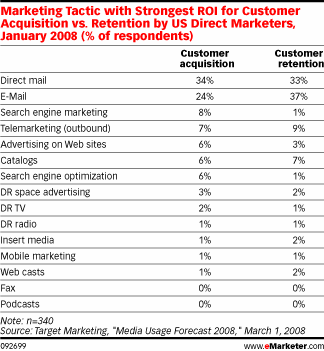Yesterday I sent a results report to a client for a pay-per-click (PPC) search lead generation campaign that my team managed. It showed a performance that was five times higher, in terms of cost-per-lead, than a traditional direct mail campaign. That’s pretty cool. But as I sent the report, I was reminded of this recent report from eMarketer:

It shows how a majority of marketers favor direct mail for lead generation versus search marketing. Scott Brinker was rightly puzzled by this, in a recent post. I agree with Scott that a chief reason for this strong preference for direct mail over search engine marketing (34% versus 8%), when it comes to customer acquisition, is the difficulty many marketers face in getting search prospects to convert.
Indeed, if the lead acquisition campaign my team was leading was instead a customer acquisition campaign, the results would likely have been closer to a dead heat with direct mail in terms of ROI.
But what does that mean? Just that we’re not trying hard enough. As marketers, I feel we cannot allow so many opportunities for conversion to click away from landing pages. There are many tested techniques for improving conversions (new offers, testimonials, guarantees, Web 2.0 landing page design). There are also spectacular new tools to do multivariate testing of these techniques.
Let’s take direct mail for what it should be. It is (usually) the customer acquisition benchmark. Now let’s shift more resources online, but apply them where it really counts: To create campaigns that actually surpass the mail in delivering a strong ROI.